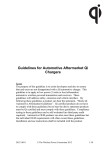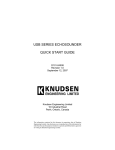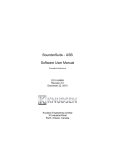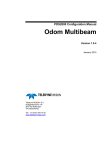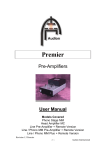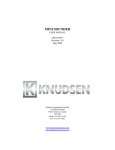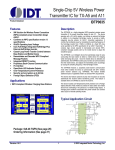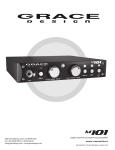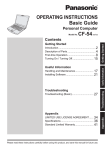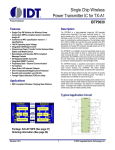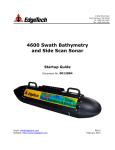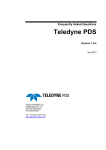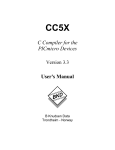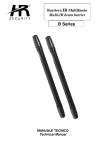Download General Info - GSE Rentals
Transcript
D101-05550-Rev1.6 - Pinger Technical Information Primary Frequency (kHz): The Pinger Wet End includes two separate interchangeable projectors - a low frequency 3.5 kHz projector ideally suited for hard sand bottom, and a 15 kHz projector for soft mud sediments Primary Frequency Electrical Pulse Power (kW): Up to 2kW. 1 kW typical. Primary Frequency Source Level (dB): 15kHz configuration - Peak transmit voltage response of 157.5dB 3.5kHz configuration - Peak transmit voltage response of 149.0dB Beam width @ 3 dB (deg): Directivity is provided by the combined effects of transmit and receive aperture. In most cases these are the same since the same transducer is used for both transmit and receive. The innovative Pinger SBP still uses conventional ceramic transducers as projectors but it incorporates a separate large aperture receive transducer, providing directivity at a fraction of the weight. 15kHz configuration - Beam width ranges from 18 deg to 9 deg over the typical frequency sweep 3.5kHz configuration - Beam width ranges from 94 deg to 23 deg over the typical frequency sweep Secondary Frequencies (kHz): The 200kHz high frequency channel provides a top of bottom reference. Bandwidth - Chirp Sweep (kHz): Primary Channel 15kHz - The default bandwidth is10 kHz (linear FM sweep of 10kHz to 20kHz). Primary Channel 3.5kHz - The default bandwidth is 6 kHz (linear FM sweep of 2kHz to 8kHz). An 8kHz chirp sweep of 2kHz to 10kHz is also common for the 3.5kHz configuration. Secondary Channel 200kHz - The default bandwidth is10 kHz (linear FM sweep of 195kHz to 205kHz). Bandwidths up to 20kHz can be set in software. Pulse Width (ms): Primary Channel 15kHz - 0.0625ms, 0.125ms, 0.25ms, 0.5ms, 1.0ms, 2.0ms, 4.0ms, 8.0ms, 16.0ms, 32.0ms, 64.0ms Primary Channel 3.5kHz - 0.0625ms, 0.125ms, 0.25ms, 0.5ms, 1.0ms, 2.0ms, 4.0ms, 8.0ms, 16.0ms, 32.0ms, 64.0ms Secondary Channel 200kHz - 0.0625ms, 0.125ms, 0.25ms, 0.5ms, 1.0ms, 2.0ms, 4.0ms Pulse Rate (pulses per second): The maximum pulse repetition rate is 20 Hz. This ping rate can be set in software, but is also dependent on the size of the acquisition window, pulse length, and default duty cycle (up to 10%). Three things affect the final ping rate of the Echosounder: the Range (or more precisely maximum acquisition window depth), the transmit Pulse Length, and the Ping Rate Control set via the EchoControl application. The system will only ping as quickly as is feasible based on the limitations imposed by these various conditions. Range Once a ping is transmitted, the system listens for a received pulse for a time equivalent to the two-way travel time of the maximum acquisition window depth. For a 100m end depth and assuming speed of sound to be 1500m/s, this works out to 0.13 seconds. Pulse Length The version of software being used on the Pinger Shallow Water SBP has a built-in 10% Duty Cycle limit imposed. So for a 64ms pulse, the time between pings is limited to 0.64 seconds - regardless of the maximum window depth. D101-05550-Rev1.6 – Pinger Technical Information -1- Ping Rate Control This is a control within the user interface allowing the transmit interval to be set. The user can adjust this ping rate to the optimal value for the application. The echosounder will then ping at this rate if possible; built-in ping rate limitations as detailed above may override the basic value selected. Depth Rating (m): Pinger is designed specifically for shallow water sub-bottom profiling (4m up to 300m) and is intended for a simple over the side pole mount installation and not to be deployed as a towed fish. Range (m): High resolution echogram data for the entire water column (set by user, up to 300m) is recorded at all times. The control software allows for dynamic window positioning and sizing as set by the operator. Sediment Penetration (m): Penetration is dependent not only on signal properties (such as frequency) but many external factors (primarily local sediment properties and to a lesser extent the depth of water). Because of this, it is extremely difficult to predict and specify the amount of usable penetration achievable for each specific survey area. Sample data for both 3.5kHz (in hard packed sand) and 15kHz (muddy bottom) are shown in Figures 1 through 5 of this document. Additional data is available upon request. Range (Vertical) Resolution (cm): assuming speed of sound to be 1500m/s Primary Channel 15kHz - Theoretical range resolution of 7.5cm for typical frequency sweep. Primary Channel 3.5kHz - Theoretical range resolution of 12.5cm for typical frequency sweep. Theoretical vertical resolutions less than 10cm are achievable. Secondary Channel 200kHz - Bandwidths up to 20kHz giving theoretical vertical resolutions of 3.75cm are achievable. Sync Control The SYNC IN signal is a 5V tolerant input that is internally pulled up to 3.3V. The signal is edge-triggered high to low and should be more the 1ms but less than 50ms in duration. The Pinger will initiate a transmit and acquisition cycle within 1ms of receipt of the sync signal assuming it is ready to ping at the time of receipt. The SYNC OUT signal is 3.3V and 1ms in duration commencing at the start of each ping cycle. Knudsen systems have been synced to multibeams in the past. Interference Pinger has a 200kHz high frequency element that is used as a top of bottom reference. This channel can be configured such that the Pinger system does not pick up any interference from other sonar equipment such as multibeam systems. Concerning whether or not the Pinger 200kHz signal will show up in multibeam records, that question is better suited for the multibeam manufacturer. To eliminate any potential for crosstalk, there is an option to turn the high frequency channel off and acquire only low frequency data. Peripherals With all of our new systems (Pinger included), peripherals such as GPS and Heave connect through the host computer. If the laptop does not have a serial port, an RS-232 to USB adapter will likely be required. A 4-to-1 Serial to USB converter that we have tested and are familiar with is Model US9ML2-4 from B&B Electronics. Wet End Mounting Options Pinger is typically mounted in one of two ways - described below. Photos are available upon request. Option 1 - Seamless pipe fitted to mounting post. The stem coming out of the top of Pinger is sized to fit inside NPS 1.25" SCH 40 pipe. Drawing D101-05189-Rev2 (available upon request) illustrates the required pipe dimensions and hole cutout specification. Option 2 - Flange on pole. Put a flange on the top of a short stub that fits over the center post, and then D101-05550-Rev1.6 – Pinger Technical Information -2- weld (or bolt) a matching flange on the end of your over the side pole. Drawings D101-05446-Rev1 and D203-05400-Rev1 (available upon request) provide details on the flange. Transducer and Pipe Support (from force of water while boat is underway) One approach is to attach a line (rope, cable, chain, etc.) to the mounting pole itself, as far down as possible (close to the top of the fairing). Drilling a hole through the pipe and installing an eye-bolt is a simple and secure way to connect the line Transducer Installation Depth At minimum, the Pinger wet end must be fully submerged and clear of turbulent water and air bubbles. It is further recommended that the transducers be mounted 1m (or more) below the water surface, but this is not always feasible given certain installations and survey areas. When operating the transducer extremely close to the water surface (wet end only partially immersed for example) there is a possibility that the low hydrostatic head at the radiating face may result in cavitation at high transmit power levels. This would degrade both transmit power and receive sensitivity, and can even damage the transducers. Connector Grease The connectors should be lubricated with Molykote 44 Medium before every mating. Refer to SubConn Handling Instructions for additional information – link provided below. http://macartney.com/sites/default/files/SubConn%20handling%20instructions.pdf Dry End Power Supply An AC/DC (24V) converter is supplied with the system. For battery hook-ups, we recommend that they be connected to output 24V. This not only keeps the current lower but results in increased efficiency of the dry-end. Power Requirements Start-up (impulse) : 72W (3A at 24Vdc) Quiescent (standby) : 18W (0.75A at 24Vdc) Operating (nominal) : 36 W (1.5A at 24Vdc) Operating (max) : 66W (2.75A at 24Vdc) Control Computer Requirements Any new commercial laptop over $500 should work just fine. We recommend a minimum of 2GB SDRAM however. With all of our new systems, peripherals such as GPS and Heave connect through the host computer. Toughbooks are attractive because they typically have built in serial ports, whereas most other modern laptops do not. If the laptop does not have a serial port, then a USB to COM adapter or network to COM adapter is required. SBP/BATHY Switch The Pinger system is equipped with an SBP/BATHY switch that can be toggled at the dry-end inside panel. The standard operational mode for the Pinger with the PVDF array is with the switch set to SBP mode. When the switch is set to BATHY mode, the PVDF receiver is bypassed and the received signal comes via the transducer as is standard in normal survey systems. The advantage of the separate receive array in SBP mode is most apparent in shallow water conditions where the ringing of the transducer in normal BATHY operations would overpower and mask the desired sub-bottom details. The SBP mode through the PVDF has also been equipped with additional signal amplification to provide stronger signal levels to pull out weak layers in the sub-bottom details. Boat Speed Range The hydrodynamic design of the Pinger Wet End allows for data acquisiton at boat speeds as high as 10 kts (installation dependent). That said, the recommended survey speed is in the 6 kt (and less) range. With sub-bottom profilers it is advantageous to acquire a high density of data points along the survey line. Increasing the number of along track data points can be accomplished by both travelling at slower boat speeds and taking advantage of the Pinger systems high (10%) duty cycle. D101-05550-Rev1.6 – Pinger Technical Information -3- Hull Mounting Pinger was designed for over the side pole mounting applications, but hull mounting is a possibility. The simplest way to hull mount Pinger would be to put a flange on the top of the shortest possible stub attached to the centre post, angle the flange to match the angle of the hull at that point, and weld (or bolt) it on. Also, a through-hull penetrator would be required for the cable. The assembly could be installed by a diver without too much difficulty. In this configuration, the system would not require any regular servicing. There are of course other ways to hull-mount Pinger that are more involved. We can forward on alternative thoughts and comments, but a naval architect or someone more familiar with the vessel may be better suited to provide suggestions for a permanent mounting solution. Digitized Depth Recording The 200kHz data channel on the Pinger SBP can record digitized depths to an ASCII data file format (KEA) along with other user-selected data fields if desired. The enabling of the available data fields is userselectable but the ordering of the data fields is not user-selectable. The 200kHz data channel's digitized depth data can also be sent to an external data logger system via the serial or UDP interfaces. Refer to document D101-05372-Rev1.1 for information about the message formats supported. The same feature is available for the low frequency channel. Accuracy Absolute accuracy is invariably limited by the accuracy with which the speed of sound in the water column and sub-bottom is specified. For more detailed information on this, refer to document D101-02251-Rev4.1. Cable Length The standard cable length as quoted is 10m. Longer cables are available as options. Heave Compensation Pinger has the ability to correct for heave, but not pitch and roll. All three can be recorded, but compensation is only done for the heave. Remote Operation The Pinger SBP is controlled by Knudsen EchoControl software (which is set up as a Client-Server architecture). The server-side application, EchoControlServer.exe, runs on the host PC (the one physically connected to the sounder) and communicates with the Pinger Dry End using the USB interface. The clientside application, EchoControlClient.exe, can run on either the same host PC as the server-side (stand-alone option) or on another PC on the same network (multiple PC option). The client-side application allows the user to control the echosounder, display full echogram data on the PC monitor, capture signal data, perform standard depth logging, and record in real time to a thermal printer. Data Output and Format There are four possible output file formats: KEB (Binary - Knudsen Proprietary), SEG-Y, KEA (ASCII configurable), and XTF. Any combination of available formats can be recorded simultaneously. Additional information on data output as well as file format specifications can be found in the User Manual (D101-05517, available upon request). Real Time Data Export There are various data logging output formats available ranging from a configurable user-defined format to industry standard protocols. The data can be output over serial ports (RS-232/RS-422) or over Ethernet 10/100 LAN (UDP Broadcast). Refer to 101-05372 (available upon request) for additional details. All data can be stored with position and time (PC's time at time of recording). Supporting External Data Input Pinger interfaces to peripheral devices such as GPS receivers and heave sensors through the host PC's serial (typically RS-232) ports. The SounderSuite software (which runs on the host PC) is set up to support a number of peripheral devices. These include: GPS Receivers: NMEA, GGA, GLL, and GMP, Heave Sensors: TSS1 and TSS3 formats, POSMV EM1000 and EM3000 formats, and Seatex: MRU. D101-05550-Rev1.6 – Pinger Technical Information -4- SVP and Temperature Profiles A fixed speed of sound can be manually entered through the EchoControl graphical user interface. Event Marks Compliant - Event marks can be initiated from a number of sources. Event Annotation (application parameters) can be defined through software. Data Logging When recording is enabled, the selected data output formats are recorded to a user specified location on the control PC. Dimensions - Dry End Length: 488 mm Width: 386 mm Height: 185 mm Weight: 10.5kg Dimensions - Wet End Length: 864 mm Width: 514 mm Height: 381 mm Weight: 21kg - 15kHz option, 29kg - 3.5kHz option D101-05550-Rev1.6 – Pinger Technical Information -5- Figure 1 – 3.5kHz, 6-9m water depth, 11m penetration in hard packed sand Figure 2 – 3.5kHz, 6-9m water depth, 11m penetration in hard packed sand Figure 3 – 15kHz, 20-30m water depth, 25m penetration in glacial lake, soft sediment D101-05550-Rev1.6 – Pinger Technical Information -6- Figure 4 – 15kHz, 20-30m water depth, 25m penetration in glacial lake, soft sediment Figure 5 – 15kHz, 40-90m water depth, 45m penetration in glacial lake, soft sediment D101-05550-Rev1.6 – Pinger Technical Information -7-









